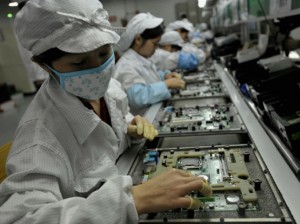Foxconn, Apple’s giant Taiwanese manufacturing partner, denies reports that workers at one of its Chinese factories went on strike Friday and says the only disturbances happened earlier in the week but were squelched right away.
The labour rights group that reported a strike says issues are not resolved, however. And China’s factories face challenges not only with labour matters, but also its general approach to manufacturing, and global attention to its practices, notes one analyst.
Foxconn’s e-mailed statement answers the claim by labour rights group China Labour Watch that thousands of workers went on strike at a Foxconn factory yesterday, bringing some iPhone 5 production lines to a halt.
The labour watchdog group said 3000 to 4000 workers refused to work at a Foxconn complex in Zhengzhou because of increasing quality controls as well as an order to work through a week-long national holiday that began on Monday.
Foxconn, for its part, says employees who worked through the holiday volunteered to do so and were paid three times their regular hourly rate. The company also says the only issues with workers occurred October 1 and 2 and were “immediately addressed and measures taken, including providing additional staff for the lines in question,” Reuters reports.
Foxconn also says reports of a strike are inaccurate and that work hasn’t stopped at the Zhengzhou facility or any other. “[P]roduction has continued on schedule,” its statement reports.
Even so, Foxconn’s Chinese plants have had problems before. Last month, 2000 workers rioted at a factory in Taiyuan after what workers described as aggressive behaviour from security guards.
In spite of Foxconn’s claims that everything is just fine, the company has been cracking down on workers to prevent tiny indentations on the iPhone 5–the anodized aluminium on its back and edges is easily scratched and marked, especially on the black model.
China Labour Watch had claimed that a fight between workers and quality-control inspectors resulted in some injuries that sent some people to go to the hospital.
“They have such high expectations for these products, even if you raise the demands a little bit it makes a huge difference to the pressure on the workers,” says Li Qiang, China Labour Watch’s executive director, in an interview.
The Foxconn workers who went on strike Friday returned to work on Saturday, according to China Labour Watch.
It’s hard to even verify situations like a rumoured strike in China because of the way the government censors how people use websites such as Facebook, Twitter and Google, which might perpetuate things such as a photo of a work stoppage, notes Roger Kay, tech market analyst and founder and CEO of Endpoint Technologies.
“We do know that there’s labour issues in general in China,” Kay says. “It’s clear from the suicides, it’s clear from strikes that have occurred, so whether or not this particular strike was minor and cleaned up quickly or major and ongoing, we know there is an issue there. It’s not just Foxconn but it’s the Chinese manufacturing system in general that’s in question.”
He expects Foxconn and other manufacturers will increasingly deal with worker complaints, which have drawn interest beyond its borders. “As labour gets more entitled it demands more in terms of work hours, work conditions and wages and it adds expense to the bill of materials,” he says.
It’s not just cheap labour that makes China the centre of manufacturing, Kay says. China first lured manufacturers to its coast with tax breaks and investments in infrastructure such as roads and electricity. Lax labour and environmental laws also help draw electronics makers, because they didn’t have to spend money to make sure that these things were done right, Kay says.
“But then it became self-fulfilling, which is I’m sure what the Chinese had in mind. Once everyone was already there, like in Shenzhen, that’s where you had to be because you need to be near your suppliers and your suppliers are all there,” Kay says.
But recently, some companies like Hewlett-Packard and Acer have moved their factories to China’s interior where it’s cheaper to operate. Employees are not the biggest or only expense, Kay says.
“The labour input to many electronics is only 1 percent and so if your labour costs twice as much or half as much it would be the difference between a half a percent, 1 percent and 2 percent, so it’s not a real big number in terms of the bill of materials cost for an electronics item,” he says.
“The economics of making an iPhone are such that there has to be a tremendous distillation of value in China and then delivered to the United States so that somebody here can buy a really nice iPhone for $700 list,” Kay says. “I feel like there’s a tension there that is ultimately not sustainable but I don’t know what the resolution is.”






